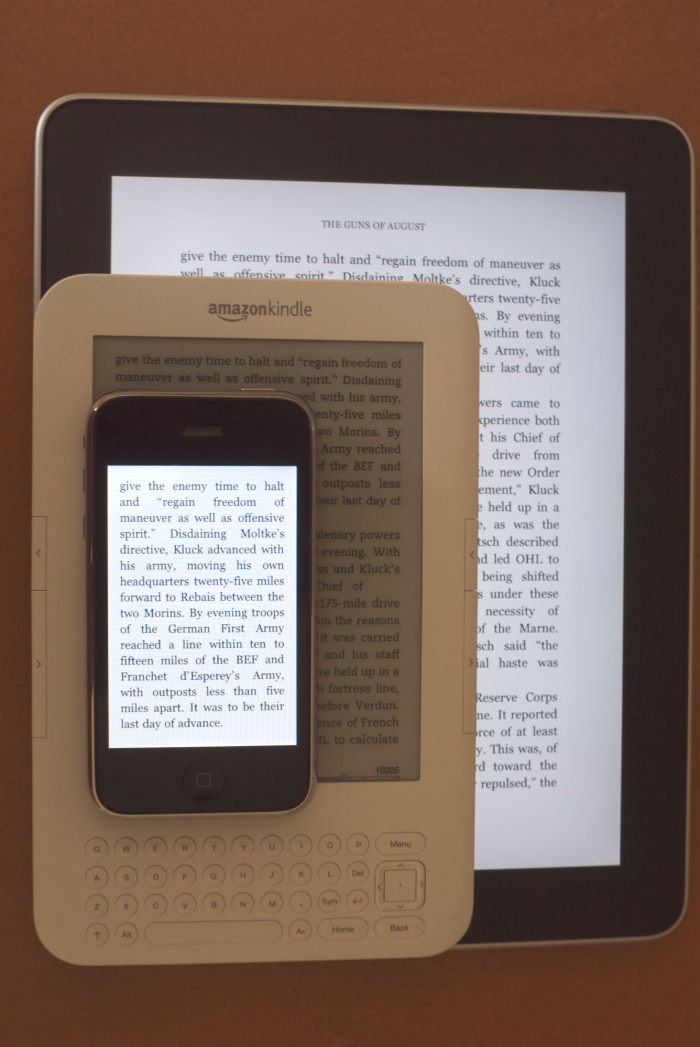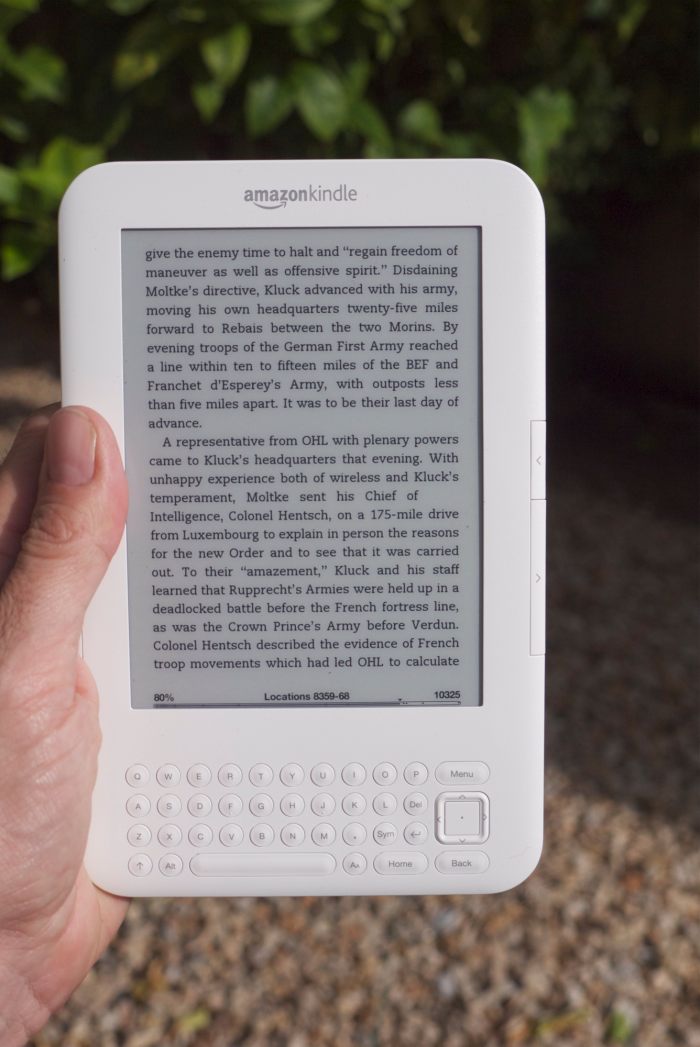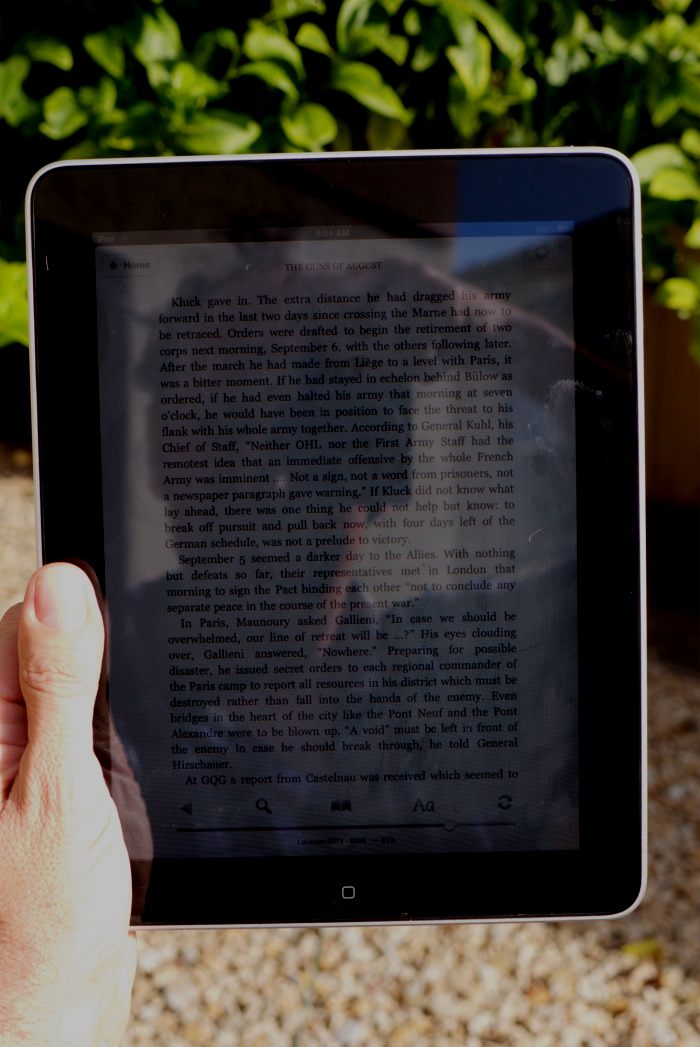A mixed bag and mostly disappointing.
When Amazon announced the latest version of their Kindle monochrome book reader I took the bait. At $139 ($189 with 3G) the cost is low enough to make acquisition an impulse purchase and, indeed, I expect the device to be free in a couple of years with your first purchase of x books from Amazon.

iPhone 3G, Kindle, iPad indoors in indirect natural light.
First, let’s be clear. The Kindle competes with the iPad in only one regard and that is as a single purpose book and periodical/newspaper reader. Its use to photographers is extremely limited as it cannot display color, has a small screen and is mostly useful if you upload your PDF instruction books to it. The bulk of the device is so low and the weight even lower, that it makes sense to take the Kindle with you in preference to the various instruction books for your picture computer, aka the modern digital camera.
Amazon ships the Kindle pre-registered in your name, a nice touch, and adding your wifi network at home is a matter of moments. There’s a nice pre-loaded instruction book (why does Apple make you download that for the iPad?), the recharger is minuscule and a nice long USB/recharger cord is provided to charge the device. Mine came 50% charged and power consumption is so low (the Kindle’s display is always ‘on’ – switching it off merely switches off wifi and the related power drain) – that you can expect days of continuous use on one charge. When ‘off’ the screen displays a portrait of one of any number of famous authors. A nice touch.
So while the Kindle does not compete with the iPad, there’s no denying that it’s hard not to make comparisons and, in a word, the Kindle is plain awful when thus judged.
The feel is ‘throw-away-plastic’ rather than ‘Leica-fixit-when-it-breaks’. The ergonomics are simply foul. Lots of tiny buttons, awful placement of the ‘back’ button right below the five way controller, no touch screen (I kept touching mine, after so many happy hours with the iPad) and, worst of all, the page forward and back buttons – which are duplicated along the long sides – could not be placed worse. Every time I pick the Kindle up I do so by spanning it with my hand to grasp the long sides, thus avoiding actuating any of the keyboard buttons. This immediately causes pages to flip and I lose my place. Horrible – did anyone actually try using this ergonomic horror? Further, every time you change pages you get a disconcerting ‘flash to black’ like with an old fashioned mirrored SLR or DSLR.
The Kindle’s screen technology when used indoors is equally poor. The background is a light gray, the contrast is accordingly low, the screen is small and unless you have direct light shining on the screen it’s an eyestrain to read. Look at the picture above. Awful.
Many make much of the Kindle’s low 8 ounce weight compared to the iPad’s 24 ounces and, frankly, that’s nonsense. The iPad weighs no more than the average book, you do not hold it elevated but rather supported on a lap or in bed (just as you do with a book) and holding the Kindle aloft is simply a pain in the you-know-what, but you find you have to do that to get close enough to the small screen. The iPad’s weight is not an issue. Don’t be told otherwise. Or, if you prefer, return to your 48 oz. netbook or 80 oz. MacBook. That’s weight.
So why would anyone buy a Kindle? You only need look at the next two snaps and you will likely buy one. These show the iPad and Kindle in direct sun.

Kindle in direct sun. The grey background does a lot to reduce eye strain in bright light.

iPad in direct sun. Useless.
Here you can see the two best and worst features of the devices – the Kindle screen just gets better as the light intensity rises and the iPad not only sucks in the sun, it’s made impossible to use by the Chief Fetishist’s insistence on glossy screens only for all Apple’s devices. So at $139 if you live in a place with sun and like reading outside (meaning CA, Florida, southern Spain, France or Italy, I suppose) buy one. The $189 version is a waste of money, though that’s what I got. You simply load up your books at home using wifi. 3G, I thought, would be nice for on the road download of newspapers, but as Amazon and the publishers idiotically insist on charging you yet again even if you already have an iPad or desktop subscription, and because the Kindle version of the WSJ or NYT is severely edited, 3G makes no sense unless you get an urge to buy books from the Kindle Store when in an area without wifi. Worse, while you can access a mere couple of dozen famous blogs, Amazon wants to charge you for that too! Why on earth would I pay for something I can get free on multiple other devices? Mr. Bezos, what have you been smoking?
There is one reason, however, to get the 3G model. For the occasional beach or outdoor reader, 3G allows you to use Whispersync to pick up a book where you left off on your iPad or iPhone or other Kindle device. And as the 3G service has no recurring monthly cost (unlike with the iPad) you can just about convince yourself that it makes sense, if you try hard. Of course, the 3G service is from AT&T so better first decide if your place of contemplated use can get AT&T reception. If not, the Kindle falls back on the even slower EDGE system, which is better than nothing and has good US coverage.
The book shown on the screen, by the way, is Barbara Tuchman’s splendid ‘The Guns of August’ detailing the ‘outbreak’ (meaning unilateral unprovoked German aggression and the usual German atrocities) of WW1, each device at the same page owing to Amazon’s excellent ‘Whispersync’ technology which keeps all books you are reading using the Kindle or a Kindle app in sync. That’s the only other feature to like about the Kindle.
Bottom line? It’s no bargain. $139 if you like to read in the garden on sunny days or at the beach.
Update September 27, 2010:
Thank goodness for Amazon’s 30-day money refund policy. Today is my thirtieth day with the Kindle and after daily use throughout that period I am returning it. It simply got more and more frustrating to use, especially in its inability to allow the user to reset the last page read when trying to reread a book, rendering synchronization between devices inoperable.
You can see my review at Amazon by clicking here. The many ill informed comments – which I refute strongly – show confirmation bias at work. You bought it so you have to like it ….